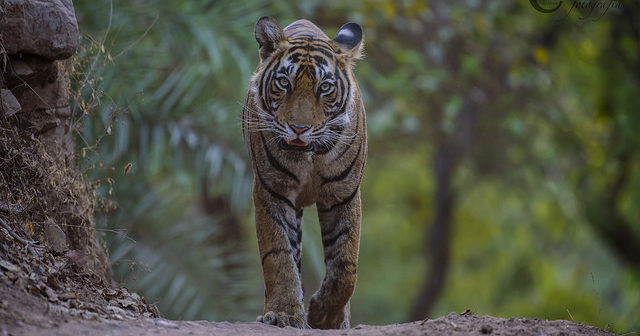Wildlife in India has been in a state of crisis since the time of the Mughals, when killing tigers, who were then considered merciless blood-sucking beasts, was the biggest trophy. Emperor Jalal-ud-Din Muhammad Akbar of the Mughal dynasty enjoyed hunting as a sport. His reign gave rise to trophy hunting, called ‘shikar’ in India. Paintings from the period depict Mongol, Rajput, Turk and Afghan nobilities hunting on elephants or horseback. These outings were considered exotic and heroic, with tigers being the ultimate trophies.
The British were no different, staging elaborate hunts to showcase their wealth, masculinity and honor. After ascending to the throne in 1911, King George V and his aides traveled north to Nepal, slaying 39 tigers in 10 days. Colonel Geoffrey Nightingale shot more than 300 tigers in India. In less than 50 years, from 1875 to 1925, humans managed to kill more than 80,000 tigers in the country. And while most killings were trophy hunts, some considered tigers vermin, and the big cats were systematically exterminated, with incentives from the government.
After India’s independence, killing tigers for sport escalated, with hunters from around the world coming to India for a guaranteed trophy, advertised by the Indian travel industry. Because the biggest animals made the best trophies, the largest, strongest cats disappeared from the gene pool. By 1971, when hunting was outlawed by the Indian Government with the Wildlife Protection Act, most of the tigers in the country had been killed.
Illegal land encroachment due to human over-population, demand for tiger skin and bones for beauty and medicine products, and illegal hunting practices for entertainment reduced the tiger population in India to 1800 by the year 1971. Populations were so low that there were assumptions that tigers would be extinct by the end of the year 2000.
To protect tigers in the country, Project Tiger was launched in the year 1973, which still stands as one of the most comprehensive project to protect tigers across the country. Today, we have less than 2500 tigers in India, which is more than 50% of the total global tiger population.
In recent years, special focus has been given to tiger conservation, with several organisations like World Wildlife Fund (WWF), Wildlife Protection Society of India (WPSI), Wildlife Conservation Society (WCS) and others working towards protecting the endangered species. But have these efforts by conservationists and animal lovers successfully stopped the bureaucrats and the politicians from imposing their will? Royalty then and supremacy now occupy similar positions. Whoever’s in charge, tigers seem to stand no chance in a world dominated by humans.

One of the 2500 remaining wild tigers in India. Image credit Allan Hopkins, CC BY-SA 3.0.
Recently, a tiger named Avni-a, or T1, was hunted down and shot dead in the forests of Yavatmal in Maharashtra on claims of her being a man-eater. According to locals and the forest officials of Maharashtra, she killed and devoured 13 human beings in the past year and a half. Many assert that there was no proof of Avni killing those 13 people in the village, and the shoot to kill order was given to free the land of tigers, so as to aid industrialists in starting development in the area. A hunter, Nawab Shafath Ali Khan, was given the task to tranquilize or kill the tigress Avni, a mother of two ten-month-old cubs. Post-mortem reports have revealed that no attempts were made to capture Avni, and she was directly shot after several months of searching for her.
In an attempt to protect Avni from a torturous death, there was a loud uproar on social media with the hashtag #LetAvniLive, and several marches in major cities across India. There was an appeal to the President and the Prime Minister of our country to save the tigress, but no efforts were made by the government or the forest officials of Maharashtra to capture Avni alive.
Avni’s death puts a big question mark on the conservation efforts the government is making to protect this endangered species. The highest court in the country upheld the order to shoot the tigress, in spite of several attempts by celebrities, media and animal activists to stop Avni’s death. It was not just the death of Avni, but the death of democracy, and of our efforts to conserve the little left wildlife in the country.
Next in line is a leopard who has been labeled a man-eater in the Bageshwar district of Uttrakhand, and private shooters are being called to kill the cat. These cases also raise a question as to why private hunters and shooters are appointed when India’s forest departments have nearly 90,000 workers on their payroll, many of whom are trained with tranquilizing guns to prevent such inhumane killing of an animal.
These are just some examples out of many where human greed has been the cause of destruction in the lives of animals. Human settlements continue to grow and encroach on their land, leaving them to live in only about 10% of India’s total potential tiger habitat of 300,000 square kilometers [115,830 square miles]. Animal density in many of these forest areas is high, and overcrowded tigers sometimes venture outside their immediate territory in search of food. Poachers have gained from this situation by killing tigers and bribing villagers to set up traps.
What we need from the government is the expansion of reserved land for animals, and an increased awareness of the threat of a global extinction of tigers. Stricter forest administration is required to prevent poaching of not only tigers, but all other animals for their skin, tusks, horns and bones.
Featured image: A wild tiger in India. Image credit C Fotografia, CC BY-SA 3.0.





